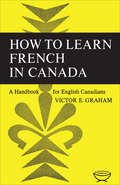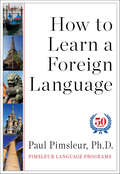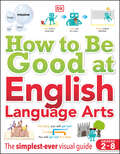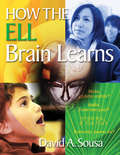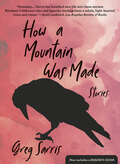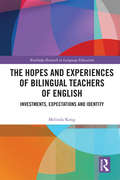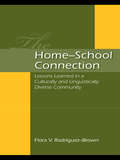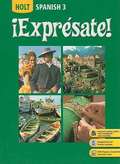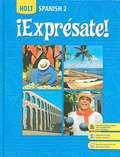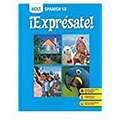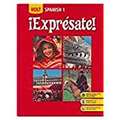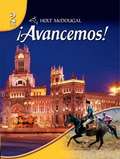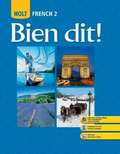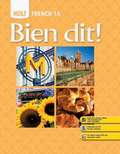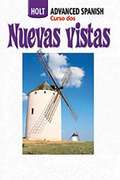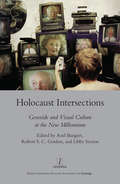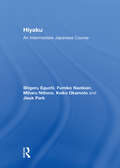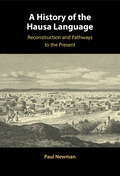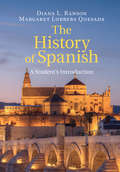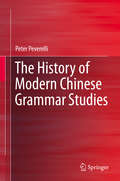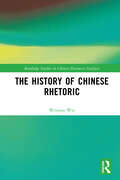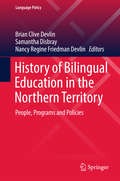- Table View
- List View
How to Learn French in Canada: A Handbook for English Canadians
by Victor E GrahamIt is well known that even after several years' exposure to high-school French, most English Canadians remain unable to speak the language. It is equally well known that many French Canadians are bilingual. One of the more obvious explanations for this relative deficiency on the part of the English Canadian is his lack of opportunities to use the French language in day-to-day situations, and, conversely, the French Canadian's need to know the second language, too often perhaps for economic reasons. Professor Graham's book gives useful and practical suggestions on how to go about becoming fluent in French. It offers not a course of instruction, but a listing of practical ways of applying oneself to a study of the language. There is specific, up-to-date information and advice regarding services provided by the governments of Quebec and France, courses offered in various Canadian communities, clubs and societies, correspondence courses, universities and summer schools, and language laboratories. A feature which will be especially helpful for those in remote areas is the listing of publications (books, newspapers, and periodicals), music and songs, records, films, and radio and television programmes which provide instruction in French. The reader will quickly see that the available means are much more varied than he realizes, and it is in providing this concise, convenient enumeration of them that Professor Graham performs a great service. Any adult who is reasonably proficient in French, but wishes to improve, will find this a practical and useful guide to ways of making a personal contribution to bilingualism in Canada. This study has been prepared under the sponsorship of the Canadian Association for Adult Education.
How to Learn a Foreign Language
by Paul PimsleurIn this entertaining and groundbreaking book, Dr. Paul Pimsleur, creator of the renowned Pimsleur Method, the world leader in audio-based language learning, shows how anyone can learn to speak a foreign language.If learning a language in high school left you bruised, with a sense that there was no way you can learn another language, How to Learn a Foreign Language will restore your sense of hope. In simple, straightforward terms, Dr. Pimsleur will help you learn grammar (seamlessly), vocabulary, and how to practice pronunciation (and come out sounding like a native). The key is the simplicity and directness of Pimsleur’s approach to a daunting subject, breaking it down piece by piece, demystifying the process along the way. Dr. Pimsleur draws on his own language learning trials and tribulations offering practical advice for overcoming the obstacles so many of us face.Originally published in 1980, How to Learn a Foreign Language is now available on the 50th anniversary of Dr. Pimsleur’s publication of the first of his first audio courses that embodied the concepts and methods found here. It's a fascinating glimpse into the inner workings of the mind of this amazing pioneer of language learning.
How to Be Good at English Language Arts: The Simplest-ever Visual Guide (DK How to Be Good at)
by DKIdeal for home learning, this simple and inspirational book has everything you need to get to grips with grammar and punctuation, and master essential reading and writing skills.Need help telling your adjectives from your adverbs? Struggling to work out what that poem is really about, or where to begin with your essay? Then this may be the book for you! How to be Good at English Language Arts uses short, straightforward explanations and clear graphics to shed light on the trickiest of topics, making this language-learning book the perfect guide to understanding and using the English language.Illustrated examples make daunting grammar accessible and fun, and help develop an understanding that can be applied to school studies. Annotated texts complement concise, practical guidance to support students in developing sound analytical and writing skills. The carefully selected reading recommendations will inspire reading for pleasure, while clear links between topics will ensure that students not only understand language techniques but know how to apply them effectively.Dive into the pages of this great grammar guide for kids to discover: -Visual explanations make concepts easy to grasp at first glance-Every topic is broken down into short sections of text written in simple language-Annotated texts provide students with clear guidance on identifying and applying language techniques effectively-&“Further reading&” features encourage reading for pleasure-&“World of words&” features bring English to life, connecting language on the page with language in the real world How to be Good at English Language Arts will inspire students to uncover and enjoy the art and power of language, supporting them on their way to becoming confident and accomplished readers, writers, and speakers. The highly visual approach alongside clear, short explanations breaks down the language and makes the subject easy to understand, whilst also supporting education curricula around the world for children aged 9-12; it is also suitable for foreign students studying English language and literature, and an ideal resource for children studying at home.
How the ELL Brain Learns
by Dr David A. SousaRaise your ELL success quotient and watch student achievement soar! How the ELL Brain Learns combines current research on how the brain learns language with strategies for teaching English language learners. Award-winning author and brain research expert David A. Sousa describes the linguistic reorganization needed to acquire another language after the age of 5 years. He supplements this knowledge with immediately applicable tools, including: A self-assessment pretest for gauging your understanding of how the brain learns languages Brain-compatible strategies for teaching both English learners across content areas An entire chapter about how to detect English language learning problems
How a Mountain Was Made: Stories
by Greg SarrisIn the tradition of Calvino's Italian Folktales, Greg Sarris, author of the award-winning novel Grand Avenue, turns his attention to his ancestral homeland of Sonoma Mountain in Northern California. In sixteen interconnected original stories, the twin crows Question Woman and Answer Woman take us through a world unlike yet oddly reminiscent of our own: one which blooms bright with poppies, lupines, and clover; one in which Waterbug kidnaps an entire creek; in which songs have the power to enchant; in which Rain is a beautiful woman who keeps people's memories in stones. Inspired by traditional Coast Miwok and Southern Pomo creation tales, these stories are timeless in their wisdom and beauty, and because of this timelessness their messages are vital and immediate. The figures in these stories ponder the meaning of leadership, of their place within the landscape and their community. In these stories we find a model for how we can all come home again. At once ancient and contemporary, How a Mountain Was Made is equally at home in modern letters as the ancient story cycle. Sarris infuses his stories with a prose stylist's creativity and inventiveness, moving American Indian literature in a new and emergent direction.
The Hopes and Experiences of Bilingual Teachers of English: Investments, Expectations and Identity (Routledge Research in Language Education)
by Melinda KongIn this age of internationalisation of higher education, many bilingual teachers from non-English-speaking contexts pursue their postgraduate degrees in English-speaking countries. Most programmes focus on providing content knowledge to them, while neglecting their investments. Furthermore, not much attention is given to what these bilingual teachers expect to gain from studying abroad, as well as their lived experiences and identity construction both inside and outside the classroom in English-speaking countries and when they return home. Nevertheless, these dimensions are crucial to their growth as teachers and users of English. This book explores these neglected aspects through case studies of bilinguals from various backgrounds. Through these case studies, the book examines the hopes, struggles and adaptation of bilinguals. It provides insights into what international students should realistically expect when studying overseas, and how to empower bilingual teachers, users and learners of English.
The Home-School Connection: Lessons Learned in a Culturally and Linguistically Diverse Community
by Flora V. Rodriguez-Brown"In this unique contribution to the literature on parental involvement in culturally and linguistically diverse communities, Flora Rodríguez-Brown offers a critique of family literacy programs that lack a clear design for literacy activities relevant to community goals, offering an alternative model that is grounded within an abiding respect for the parents’ role as the child’s first, and ultimately, most important teacher." Robert D. Milk, University of Texas, San Antonio The Project FLAME program used as context for this book is a comprehensive family literacy model, supported by a strong sociocultural framework based on current research on cultural ways of learning and theories of multiliteracies and discourse. The model highlights the relevance of parents’ knowledge, cultural ways, and discourses in sharing literacy knowledge with their children. A pressing need exists for models and programs that effectively serve the educational needs of the steadily increasing numbers of culturally and linguistically diverse students in U.S. public schools today. Addressing issues related to development, implementation, and effectiveness of a program model that fulfills this need, this book is an essential resource for educators, community workers, and researchers interested in the relevance of the home-school connection in relation to children’s school success.
Holt Spanish 2, ¡Exprésate!
by Nancy Humbach Sylvia Madrigal Velasco Stuart Smith John McminnNIMAC-sourced textbook
Holt Spanish 1B, iExpresate!
by Nancy Humbach Sylvia Madrigal Velasco Ana Beatriz Chiquito Stuart Smith John McminnNIMAC-sourced textbook
Holt Spanish 1, ¡Expresate!
by Nancy Humbach Sylvia Madrigal Velasco Ana Beatriz Chiquito Stuart Smith John McminnNIMAC-sourced textbook
Holt McDougal ¡Avancemos!, Dos 2 (¡avancemos!)
by Estella Gahala Patricia Hamilton Carlin Audrey L. Heining-BoyntonNIMAC-sourced textbook
Holt French 2, Bien dit!
by John Demado Séverine Champeny Marie Ponterio Robert PonterioNIMAC-sourced textbook
Holt French: 1A (Bien Dit!)
by John DeMado Séverine Champeny Marie Ponterio Robert PonterioNIMAC-sourced textbook
Holt Advanced Spanish, Curso dos Nuevas vistas
by Holt, Rinehart and Winston StaffNIMAC-sourced textbook
Holocaust Intersections: Genocide and Visual Culture at the New Millennium
by Axel BangertRecent representations of the Holocaust have increasingly required us to think beyond rigid demarcations of nation and history, medium and genre. Holocaust Intersections sets out to investigate the many points of conjunction between these categories in recent images of genocide. The book examines transnational constellations in Holocaust cinema and television in Europe, disclosing instances of border-crossing and boundary-troubling at levels of production, distribution and reception. It highlights intersections between film genres, through intertextuality and pastiche, and the deployment of audiovisual Holocaust memory and testimony. Finally, the volume addresses connections between the Holocaust and other histories of genocide in the visual culture of the new millennium, engaging with the questions of transhistoricity and intercultural perspective. Drawing on a wide variety of different media - from cinema and television to installation art and the internet - and on the most recent scholarship on responses to the Holocaust, the volume aims to update our understanding of how visual culture looks at the Holocaust and genocide today. With the contributions: Robert S. C. Gordon, Axel Bangert, Libby Saxton- Introduction Emiliano Perra- Between National and Cosmopolitan: 21st Century Holocaust Television in Britain, France and Italy Judith Keilbach- Title to be announced Laura Rascaroli- Transits: Thinking at the Junctures of Images in Harun Farocki's Respite and Arnaud des Pallieres's Drancy Avenir Maxim Silverman- Haneke and the Camps Barry Langford- Globalising the Holocaust: Fantasies of Annihilation in Contemporary Media Culture Ferzina Banaji- The Nazi Killin' Business: A Post-Modern Pastiche of the Holocaust Matilda Mroz- Neighbours: Polish-Jewish Relations in Contemporary Polish Visual Culture Berber Hagedoorn- Holocaust Representation in the Multi-Platform TV Documentaries De Oorlog (The War) and 13 in de Oorlog (13 in the War) Annette Hamilton- Cambodian Genocide: Ethics and Aesthetics in the Cinema of Rithy Panh Piotr Cieplak, Emma Wilson- The Afterlife of Images
Hiyaku: An Intermediate Japanese Course
by Shigeru Eguchi Fumiko Nazikian Miharu Nittono Keiko Okamoto Jisuk ParkHiyaku: An Intermediate Japanese Course provides a progressive intermediate course in Japanese, incorporating modern teaching methods and practicing all four language skills. Hiyaku provides content-based instruction, with authentic and semi-authentic dialogues and readings, all carefully selected to instruct and inspire students as they learn Japanese. Key features of the textbook include: highly structured chapters, beginning with warm-up exercises followed by focused practice of each of the four skills gradual introduction to increasingly authentic materials content taken from original Japanese sources such as books, TV programs, magazines, newspapers and websites extensive audio material provided as FREE MP3 files on a companion website instructor’s materials, including PowerPoint files provided through the companion website. Hiyaku does not simply teach language and basic cultural points: it also helps students gain a holistic understanding of Japanese society and history, and provides the necessary foundation for the advanced study of Japan and its language.
A History of the Spanish Language
by Ralph PennyThis is a thoroughly revised, updated and expanded edition of Ralph Penny's authoritative textbook, first published in 1991, which provides a clear and elegant account of the development of Spanish over the last 2,000 years. Although principally oriented towards 'internal' history, 'external' history is also considered and referred to throughout. In this new edition, as well as adding insights from recent scholarship throughout the text, Professor Penny has added a new chapter which discusses the nature of linguistic history, the concept of World Spanish, processes of convergence and divergence in Spanish, and the English/Spanish interface. This edition also contains a glossary of technical terms, guidance on further reading, and suggested topics for discussion.
A History of the Japanese Language
by Bjarke FrellesvigBjarke Frellesvig describes the development of the Japanese language from its recorded beginnings until the present day as reflected by the written sources and historical record. Beginning with a description of the oldest attested stage of the language, Old Japanese (approximately the eighth century AD), and then tracing the changes which occurred through the Early Middle Japanese (800-1200), Late Middle Japanese (1200-1600) and the Modern Japanese (1600-onwards) periods, a complete internal history of the language is examined and discussed. This account provides a comprehensive study of how the Japanese language has developed and adapted, providing a much needed resource for scholars. A History of the Japanese Language is invaluable to all those interested in the Japanese language and also students of language change generally.
A History of the Hausa Language: Reconstruction and Pathways to the Present
by Paul NewmanWith more than sixty million speakers across Nigeria, Niger, Cameroon, and Ghana Hausa is one of the most widely spoken African languages. It is known for its rich phonology and complex morphological and verbal systems. Written by the world's leading expert on Hausa, this ground-breaking book is a synthesis of his life's work, and provides a lucid and comprehensive history of the language. It describes Hausa as it existed in former times and sets out subsequent changes in phonology, including tonology, morphology, grammar, and lexicon. It also contains a large loanword inventory, which highlights the history of Hausa's interaction with other languages and peoples. It offers new insights not only on Hausa in the past, but also on the Hausa language as spoken today. This book is an invaluable resource for specialists in Hausa, Chadic, Afroasiatic, and other African languages as well as for general historical linguists and typologists.
The History of Spanish: A Student's Introduction
by Diana L. Ranson Margaret Lubbers QuesadaThis concise textbook provides students with an engaging and thorough overview of the history of Spanish and its development from Latin. Presupposing no prior knowledge of Latin or linguistics, students are provided with the background necessary to understand the history of Spanish. Short, easy-to-digest chapters feature numerous practice exercises and activities. Chapter 'Lead-in' questions draw comparisons between English and Spanish, enabling students to use their intuition about their native language to gain a deeper understanding of Spanish. Each chapter features further reading suggestions, an outline, and a summary. Highlighted key terms are collated in a glossary. Boxes on linguistic debates teach students to evaluate arguments and think critically about linguistics. Supporting online resources include Word files of all the practices and activities in the book and an instructor's manual featuring a sample syllabus, answer key to the practices and activities, sample exams and teaching suggestions. This book is ideal for a range of courses on the history of Spanish and Spanish linguistics.
The History of Modern Chinese Grammar Studies
by Peter PeverelliThis book discusses the way Chinese scholars developed a national grammar. Chinese didn't develop grammar until China's contact with Western grammar books in the 19th Century. The first indigenous grammar was published in 1889. It included some traditional notions, but mainly imitated European grammar. It was followed by a number of other similar works. To move away from this imitation, a group of grammarians started to look into the Chinese tradition of commenting on classics. This led to a variety of alternative grammars. After the war, Western linguistics started to gain influence in China. With the establishment of the PRC in 1949, efforts began to have a standard grammar adopted nationwide. The first attempt at such a grammar was published in 1956. This book spans the period 1898 - 1956. This book combines historiography and linguistics to distinguish different periods in the timespan covered. It shows how the development of a national grammar cannot be studied separately from language policies and discussions on the national language. The description of each period includes a general introduction of the relevant events in that period and a treatment of the major works of grammar.
The History of Chinese Rhetoric (Routledge Studies in Chinese Discourse Analysis)
by Weixiao WeiThis book challenges the existing misconception that there was no rhetoric in ancient China. Instead, this book provides ample evidence from public speeches in the Xia dynasty and oracle bone inscriptions in the Shang dynasty to public debates about government policies in the Han dynasty to show that persuasive discourse and rudimentary rhetorical techniques already existed in ancient China. Using literary analysis and discourse analysis methods, this book explains how the Mandate of Heaven was inscribed at the core of Chinese rhetoric and has guided Chinese thoughts and expressions for centuries. This book also demonstrates Chinese rhetorical wisdom by extracting many concepts and terms related to language expression, persuasive speech, morality and virtue, life and philosophy, and so on from great Chinese literary works. Well-known names, such as Confucius, Laozi, Sima Qian, Liu Xie, Mozi, Hanfeizi, Guibuzi and so on, are all touched upon with their famous theory and sayings related to and explicated from the rhetorical perspective. Many surprising facts are found by the author and revealed in the book. For example, a thousand years ago, the Chinese author Liu Xie already found that all words have preferred lexical neighbors and structural environment. This is later on ‘discovered’ by corpus linguistics and illustrated, for example, by the concepts of collocation and pattern grammar. This book targets postgraduate students, teachers, researchers and scholars interested in advanced Chinese language and Chinese literature, history, and culture.
History of Bilingual Education in the Northern Territory
by Brian Clive Devlin Samantha Disbray Nancy Regine Friedman DevlinThis book provides the first detailed history of the Bilingual Education Program in the Northern Territory of Australia. This ambitious and innovative program began in 1973 and at different times it operated in English and 19 Aboriginal languages in 29 very remote schools. The book draws together the grassroots perspectives of Indigenous and non-Indigenous practitioners and researchers. Each chapter is based on rich practitioner experience, capturing bottom-up aspirations, achievements and reflections on this innovative, yet largely undocumented language and education program. The volume also makes use of a significant collection of 'grey literature' documents to trace the history of the program. An ethnographic approach has been used to integrate practitioner accounts into the contexts of broader social and political forces, education policy decisions and on-the-ground actions. Language in education policy is viewed at multiple, intersecting levels: from the interactions of individuals, communities of practice and bureaucracy, to national and global forces. The book offers valuable insights as it examines in detail the policy settings that helped and hindered bilingual education in the context of minority language rights in Australia and elsewhere.
A History of Afro-Hispanic Language
by John M. LipskiThe African slave trade, beginning in the fifteenth century, brought African languages into contact with Spanish and Portuguese, resulting in the Africans' gradual acquisition of these languages. In this 2004 book, John Lipski describes the major forms of Afro-Hispanic language found in the Iberian Peninsula and Latin America over the last 500 years. As well as discussing pronunciation, morphology and syntax, he separates legitimate forms of Afro-Hispanic expression from those that result from racist stereotyping, to assess how contact with the African diaspora has had a permanent impact on contemporary Spanish. A principal issue is the possibility that Spanish, in contact with speakers of African languages, may have creolized and restructured - in the Caribbean and perhaps elsewhere - permanently affecting regional and social varieties of Spanish today. The book is accompanied by the largest known anthology of primary Afro-Hispanic texts from Iberia, Latin America, and former Afro-Hispanic contacts in Africa and Asia.
